Music in the air—for free
May 30, 2013
Summertime, and the concerts are easy…if you know where to look.
This year’s lineup of free open air concerts in the 3rd District features musical offerings ranging from Latin jazz to Klezmer, in settings that stretch from West Hollywood to Sylmar.
Here’s the list of the upcoming 3rd District performances. Performances in other parts of the county are here. The concerts are sponsored by the Board of Supervisors and administered by the county Arts Commission.
Posted 5/30/13
Historic bash for Natural History Museum
May 30, 2013
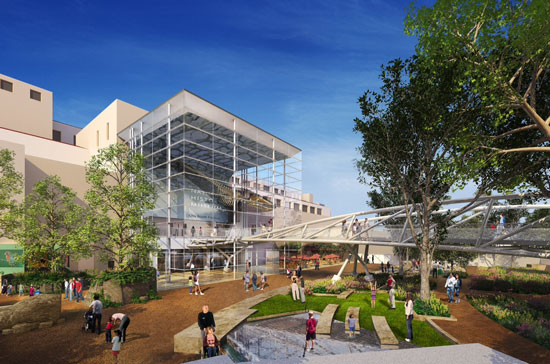
An artist's rendering of the Natural History Museum's new entry, with a fin whale skeleton suspended above.
Los Angeles was a hard-partying hick town when top-hatted civic leaders opened its first museum, toasting it with water from the then-day-old Los Angeles Aqueduct. The fairground where the new landmark stood had been a nest of saloons and gamblers. L.A. was so culturally young that, for its first acquisition, the museum touted a goldfinch nest from the San Gabriel River bottom.
But a century can make such a difference.
On June 9, the Natural History Museum of Los Angeles County will kick off its centennial with a day and night of hoopla in the rowdy ex-fairground that is now called Exposition Park. The festivities—with kid-friendly activities, food trucks, garden tours, live music, scientists and a nighttime concert by DEVO—will not only honor one of the nation’s largest and best-known natural history museums, but also will mark a milestone in the decade-long renovation and restoration.
The museum’s hallmark 65-foot fin whale will welcome guests from the top of a dramatic new glass entrance. Two Expo Line Metro stops will ferry visitors who prefer to arrive via L.A.’s burgeoning mass transit system.
A 3.5-acre Nature Garden will blossom outside a companion, state-of-the-art Nature Lab, where visitors can study wildlife, see it in action and then collaborate with science lovers region-wide in crowdsourced “citizen science” projects. Nearby, the museum’s acclaimed new Dinosaur Hall and award-winning Age of Mammals exhibits, both already opened, will be joined in July with the unveiling of the renovation’s final piece, “Becoming Los Angeles,” a permanent installation on the development of Southern California.
Meanwhile, visitors will be able to get a local history fix in the halls and rotunda of the 1913 building, which is on the National Register of Historic Places, and which has been restored and seismically strengthened.
“If you haven’t visited the Natural History Museum in a while, you should be prepared to find a vastly different institution,” says President and Director Jane Pisano. “This is a museum that has transformed itself.”
Pisano says the remodel arose from a change of philosophy at the museum.
“The old philosophy was very typical of natural history museums everywhere,” she says. “It was all about us—how we do research, how we take care of collections—and we changed that mission to focus on the visitor.”
The new aim, she says, is not to be “a book on a wall,” but to inspire wonder and a sense of discovery and responsibility in those who come to the museum. “We were doing a good job on wonder, but not so well on discovery and least well on inspiring a sense of responsibility for the natural world.”
Nor, she says, was the museum working as well as it could with Southern California’s natural landscape.
“There are very few cities that have the kind of climate we have,” she noted. So with the help of a new, county-funded garage that has consolidated parking, acres of paved land were transformed into wildlife habitat and gardens. Meanwhile, the building’s grand architecture was tweaked to create an easier flow between indoor and outdoor wonders.
Now visitors can take in the museum’s longstanding highlights—the dinosaur bones, the marine fossils—but also enjoy workshops led by master gardeners in the edible garden and unleash their kids in a “Get Dirty Zone.” The remodel also has set the stage for a long-term “citizen science” study of local biodiversity that museum experts expect to stretch throughout the Los Angeles Basin.
“This is a place where living things will come in and we can appreciate them in the wild,” says Karen Wise, the museum’s vice president of education and exhibits. “We don’t have to just have dead things on display.”
The new Natural History Museum isn’t the only cultural institution in Southern California to be reimagining the museum experience ways that are more authentic to L.A. The Los Angeles County Museum of Art under Director Michael Govan also has taken a more indoor-outdoor approach with installations such as Michael Heizer’s “Levitated Mass” and Chris Burden’s “Urban Light” on its campus. In fact, on the same day as the Natural History Museum celebration, LACMA will unveil a proposed architectural remodel that would make the county’s 50-year-old art museum literally transparent to visitors.
“I love letting the light in,” says Pisano. “I think it changes everything about the museum. I love that it’s fun, and I love that it has become a destination where visitors of all ages can come and spend the day and still not see it all.”
And, she says, there’ll be more to love as the next century gets underway at the museum. Pisano says the renovation has upgraded about 60 percent of the public space on the campus, with plenty of projects on the horizon.
“We need to redo the auditorium,” she says. “There still are exhibit galleries that need to be re-presented. We need to redo our Gem and Mineral Hall. We’ve talked about a Hall of the Americas for a long time.
“There’s a lot to be done,” says the museum director, “but I’m so optimistic about the future of this place.”
Posted 5/29/13
LACMA lights up
May 30, 2013
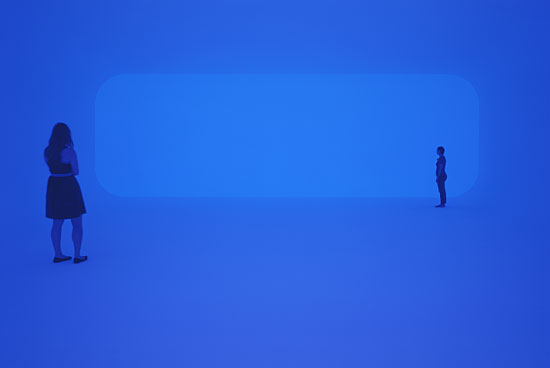
James Turrell's stunnng "Breathing Light" is part his new LACMA retrospective. Photos by Florian Holzherr
When Denver art dealer Adam Gildar heard about the James Turrell retrospective at the Los Angeles County Museum of Art, he went straight to the museum’s website for advance tickets to the widely anticipated show. Bound for L.A. with some collectors during the July 4 weekend, Gildar was particularly hoping to see “Light Reignfall,” a mind-blowing, one-person-at-a-time Turrell light show in a spherical tank that looks like something out of a sci-fi movie.
Unfortunately for him, so, apparently, is just about everyone else.
The Turrell show—packed since its opening last week, with “Light Reignfall” reservations sold out until late August—is shaping up to be one of this summer’s hottest tickets, and not just at LACMA.
On June 9, the Museum of Fine Arts, Houston, will showcase a cross-section of large and small works from its collection by the pioneering, Los Angeles-born artist. In New York, starting June 21, the rotunda of the Guggenheim Museum will be turned into a gigantic Turrell light piece.
Over on La Brea Boulevard, Turrell’s gallery, Kayne Griffin Cocoran, last week opened a new space designed by the artist, with a show tracing the 37-year history of his still-incomplete magnum opus, “Roden Crater.” The new gallery also has a signature Turrell “skyspace,” a part-skylight, part-lightshow creation that has become the new must-have architectural feature for art lovers. More than 80 have been installed worldwide, mostly for private collectors, including at least a half-dozen in homes and galleries in Los Angeles County.
“It is sort of a festival of James Turrell,” says LACMA Director Michael Govan, who co-curated the LACMA show and whose relationship with the white-bearded artist dates back to Govan’s last job at the Dia Art Foundation in New York.
And, Govan adds, the festival will be a long-running one.
Turrell’s medium is light, colored and natural, manipulated in ways that are designed to engulf and disorient the viewer. But because many of his artworks are built so that only a limited number of people can experience them at once, LACMA is expecting crowds to move much more slowly than usual through the exhibition.
“Tickets to that show are like Stones tickets,” an artist’s liaison for a large L.A. gallery confided earlier this week. “Everybody wants in.”
As a result, the museum is selling timed tickets, both to the retrospective and to high-demand pieces such as “Light Reignfall,” and extending the show for almost a year so that anyone who wants to can eventually see it. The exhibit also will stay open until 11 p.m. on Fridays from July 5 to August 30 as part of extended summer hours at LACMA’s Resnick Pavilion and the Broad Contemporary Art Museum.
For some, the thrill is in seeing the artist’s work on its home turf. Now 70, Turrell pioneered Southern California’s Light and Space Movement and made his name in L.A.
Others are looking forward to literally immersing themselves in the pieces.
At a press preview this week, a woman—helped by a pair of attendants in white lab coats—emerged from “Light Reignfall” dazed and comparing the experience to the aura from a somehow-painless migraine. Meanwhile, crowds of donors and arts writers stood in line for up to an hour for a chance to take off their shoes and climb a black-carpeted pyramid into “Breathing Light,” a 5,000-square-foot installation that creates the sensation of being suspended in a fog of luminosity.
Still others are curious about “Roden Crater,” the massive installation and “naked-eye observatory” that Turrell has been building for decades in a volcanic crater near Flagstaff, Az.
“There was a time when I was kind of worried about my career, like many mid-career artists, and thinking maybe I was going nowhere,” the artist chuckled at Wednesday’s press conference. “Now if you find yourself in the middle of nowhere, you’re probably somewhat near my work.”
Turrell jokingly compared the crater installation to an unfinished doctoral thesis, and kidded that he was raising money for its completion by “selling blue sky and colored air.” More seriously, he said this summer’s exhibition of his work has drawn attention to the multi-million-dollar project. And, he noted, his skyspace commissions not only have helped underwrite his larger work, but also have informed it, capturing light in its infinite variety.
“I remember when we had backyard burning in Pasadena, and tremendous smog here, but it’s a special, soft, beautiful sky we have here now,” he said. “Arizona has a crisp, clear, hard sky. Each of these places is different, city and country, and I like to celebrate all the different kinds of skies.”
Back under the Denver sky, Gildar the art dealer is looking forward to the retrospective, with or without “Light Reignfall.” It is, after all, the largest-ever survey of the artist’s work and the first in nearly 30 years.
And a fan can hope. Shut out at LACMA’s web site, he ran an ad offering $20 over the ticket price on Craigslist to anyone willing to sell their 12 minutes of Turrell immersion. “But it doesn’t look like there’s much of a possibility that that’s going to work out,” he says, “and that’s okay. It’ll be amazing to see any of his work.”
Posted 5/29/13
Last shootout at the O.K. Corral
May 30, 2013
For a bunch of fabled Western gunslingers, they’re a pretty static bunch, lurking laconically in the dark until somebody walks by, pushes a button and briefly illuminates one of the most notorious street fights in American history.
For the past quarter century, the nine life-sized mannequins that make up the “Gunfight at the O.K. Corral” exhibit on the lower level of the Autry Museum have kept a low profile as tens of thousands of visitors traipse by and listen to a 2-minute recording about what happened in Tombstone, Arizona on that fateful day in 1881.
“Step back with us,” the narrator intones, “for a legendary moment, frozen in time.”
But now, at long last, those stationary figures in the old-school diorama are on the move—on their way to that Great Shootout in the Sky. (Or perhaps to the Burbank Historical Society.)
The O.K. Corral exhibit is closing on Sunday, June 2, to make room for a new exhibition, “Western Frontiers: Stories of Fact and Fiction,” which opens in July and will provide a showcase for historically significant firearms and related items from the museum’s collection, including recent donations from noted collector George Gamble.
Since the O.K. Corral exhibit didn’t fit neatly into any official school curriculum guides, field trip groups at least in recent years have tended to pass it by, or leave it up to individual students to check it out on their own. But some docents have had a soft spot for the diorama—which depicts the Earp brothers and their ally, Doc Holliday, in a deadly showdown with rivals—and made sure to always route their groups toward it as they toured the museum.
“It’s been a sort of kitschy favorite of visitors over the years,” said Stacy Lieberman, the Autry’s vice president of communications and visitor experience.
The curatorial staff has been, umm, less enthusiastic.
One former curator, when he learned of its impending demise, offered to come back to be “the first person to swing the ax,” said Jeffrey Richardson, the museum’s current curator of Western history, popular culture and firearms.
Richardson goes so far as to call it “a huge waste of space,” pointing out that the exhibit makes no attempt to provide any context for the event it so briefly describes.
“One thing that people simply overlook more than anything else is that the gunfight at the O.K. Corral was fought about gun control,” he said. “You had one group that was illegally bringing arms into town and you had another group that was trying to stop them.”
Plus, “there was a love triangle between two individuals in the group,” he said. “All of this, you don’t get that context from what we have here.” (For more on that love triangle and a fascinating woman of the West, check out the new book “Lady at the O.K. Corral: The True Story of Josephine Marcus Earp.” The author, Ann Kirschner, appears Saturday, June 1 at the museum.)
For all of the O.K. Corral exhibit’s shortcomings, the reasons for phasing it out do not include concerns about showcasing firearms in the current era of profound divisions over the role of guns in American life.
In fact, the tenor of the times and the museum’s mission demand an even-handed exploration of guns and culture, Richardson said.
“It is not only appropriate, it is imperative that a museum like the Autry, that looks at the larger history of the American West, deal with an issue like firearms because firearms were absolutely essential in the history of this particular region,” Richardson said. “To tell the story of the American West without addressing firearms, not only is it inaccurate, but it does a disservice to people on both sides of the debate.”
“We’re not saying it should be glorified, or condemned,” he added. “What we are hoping to do is take an approach that puts the firearm in its appropriate historical context.”
Thus the new exhibit will deal with guns and personalities from the “historic and the mythic West,” including Annie Oakley, described by Richardson as “the most famous sharpshooter to come out of the Wild West.”
It also will include the gun belt—with its preposterously oversized bullets—worn by Steve McQueen in the TV series “Wanted Dead or Alive,” which ran for three seasons ending in 1961.
The bullets “were huge and they looked really intimidating,” Richardson said. “Those bullets would never fit into the actual gun, but they looked really, really cool on TV.”
Such elements in the new exhibit “get to the notion of what we know about the West,” he says. “People 100 years ago knew about the West because of Wild West shows. We know about the West because of TV and film.”
And now, of course, because of the Internet, where YouTube is keeping alive what will soon be a part of the Autry’s own history: the disappearing O.K. Corral diorama, which opened when the museum did in 1988.
As the exhibit ticked down its final hours this week, small groups paraded by. Even on its last legs, it commanded attention—and even a certain level of respect—from those who stopped to take a look.
“I hate that,” whispered four-year-old Kayleen Lee, who hid behind her mother as the exhibit narrator launched into his spiel. “I’m scared about them talking about guns.”
“Scary!” said her brother, six-year-old Derrick Lee. “They talk and I think they’re going to move.”
Their mother, Karen Lopez, found it a teachable moment.
“I hate guns. They don’t even have water guns,” she said of her children. But giving them a chance to learn about firearms and history “is very important. They’re like, ‘Why don’t you like guns?’ and I try to tell them the history behind it. I try to explain to them why it’s a sensitive subject.”

Annie Oakley's gold-plated gun, engraved with the sharpshooter's name, will be on display in the new exhibit.
Posted 5/30/13
It’s a safe new world for Valley youth
May 29, 2013
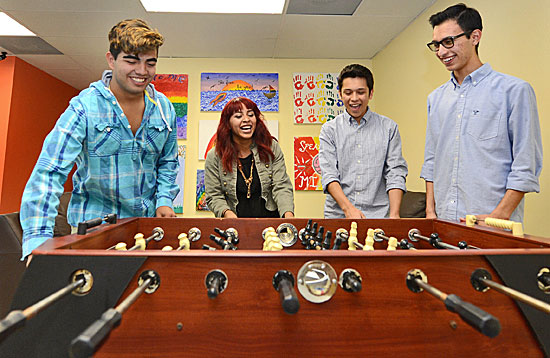
Dropping in for some foosball are, from left, Edward Murillo, Karina Perez, Anthony Barros and Mario Vasquez.
Edward Murillo knows what it’s like to need a refuge.
As a gay teenager growing up in South Lake Tahoe, he says, he was kicked out of the house a dozen times. “The first time, I slept out in the woods,” he recalls.
Now 20, and living with an aunt and uncle in Sun Valley, he’s a student at Pierce College and a leader of its Gay-Straight Alliance club.
And this week, he was definitely out of the woods, sitting in a bright and freshly painted new drop-in center for at-risk, foster, homeless and LGBT young people aged 14 to 21. The center, which formally opens Friday, is the first of its kind in the San Fernando Valley.
“I feel like if there was a center like this in Lake Tahoe, it would have been amazing. It would have made me feel a lot better,” Murillo says.
Charles Robbins, vice president of communications and development for The Village Family Services, which has created the center on the site of a former orthopedic surgeon’s office in North Hollywood, says it will serve a growing population with urgent and specific needs.
“We are going to be a heavily-used site,” he predicts, noting a “migration” of homeless youth to the Valley as crackdowns intensify in Hollywood. “Lots of these kids are coming into North Hollywood.”
He says that many of the young people end up “couch-surfing with friends,” while others frequent local libraries, public transit stations and parks.
Some offerings at the new center are geared to addressing the needs of homeless kids—showers, a washer-dryer, a few basic clothing supplies. Others, like an outdoor patio, foosball table, free Wi-Fi and “cyber lounge” with computers, along with a steady supply of healthy breakfasts and snacks, seem likely to be hits with all the young patrons, regardless of their housing status.
Beyond the amenities, planned activities include art, fitness, vocational and life-skills classes, counseling, peer and support groups and referrals to an array of services including housing and substance abuse recovery.
The center is being started with funding from 3rd District Supervisor Zev Yaroslavsky, with much of the annual operating expenses expected to come from private donors. It is on the first floor of the Valley Community Clinic, 6801 Coldwater Canyon Avenue in North Hollywood. That location, right downstairs from the facility’s Teen Clinic, offers a powerful combination of vital services under one roof.
“The Teen Clinic’s services are free, which is amazing,” says Karina Perez, 18, the president of the Gay-Straight Alliance at Pierce College and a friend of Murillo, who is the group’s public affairs officer. Onsite mental health counseling will also be available at the new drop-in center. “If you’re having anxiety or feeling depressed, they can help,” she points out.
Perez lives in North Hollywood, but others are expected to come from come across the sprawling Valley to find fellowship and support at the drop-in center.
“We come all the way down from Lancaster to support something like this,” says Mario Vasquez, 18. “Even youth from our area can come down and feel safe and respected in an environment where everyone is working together.”
Vasquez, Perez and Anthony Barros, 17, are all youth advocates with Project Q, which provides supportive services for LGBTQ (lesbian, gay, bisexual, transgender and questioning) young people at The Village Family Services. When the organization started developing plans for the drop-in center, the students played a role in shaping its identity, including helping to paint some of the colorful canvases that now adorn the walls.
“When we first got news that we got funding for the drop-in center, I was overwhelmingly excited,” Barros says. “Finally, a safe space where LGBTQ and straight allied people can come together in the San Fernando Valley. I’m really looking at this as a place where we can all feel comfortable and supported, a place where we can continue our leadership and develop ourselves as people and citizens.”
Posted 4/18/13
It’s no secret: this guy can sing
May 29, 2013
Oh sure, millions know Mandy Patinkin as Saul Berenson, the charismatic and intense CIA chief on Showtime’s critically acclaimed “Homeland,” with its legions of obsessive fans. Multitudes have howled at Bill Hader’s brilliant impersonation of Patinkin’s character on Saturday Night Live, and some have even liked the Facebook page “One Million Fans of Mandy Pantinkin’s Beard.” Zach Braff was no doubt speaking for many when he praised two of Patinkin’s most famous roles when he recently added him to the cast of his new Kickstarter-financed movie:
“When I was a child, my favorite movie was ‘The Princess Bride.’ Now that I am an adult, my favorite TV show is ‘Homeland.’ They have one thing in common: one of my favorite actors of all time is joining us to play my father: Mandy Patinkin.”
But this is not just some pop culture flavor of the month—this is Mandy Patinkin we’re talking about. And in between the childhood delights of “Princess Bride” (with the enduring catch phrase “Hello. My name is Inigo Montoya. You killed my father. Prepare to die.”) and the grownup pleasures of “Homeland” lies Patinkin’s vast and distinguished career as a star of the Broadway musical stage.
It will be this Mandy Patinkin—winner of a Tony for his role as Che Guevara in “Evita,” nominated for his star turn in “Sunday In The Park With George”—who takes the stage of the county’s Ford Amphitheatre on Sunday, June 9, at 8 p.m. to perform an array of Broadway classics and popular songs with the Pasadena Pops.
Patinkin’s performance inaugurates the Zev Yaroslavsky Signature Series, in which nationally renowned artists play the Ford as a complement to the amphitheatre’s traditional programming showcasing homegrown L.A. talent. A second Signature Series performance on August 10 will feature the New York-based Complexions Contemporary Ballet troupe, appearing with Los Angeles’ own Lula Washington Dance Theatre. Proceeds from both concerts will benefit the Ford Theatre Foundation.
Even though Patinkin’s repertoire stretches from Shakespeare to Sondheim to Showtime, this performance marks his first appearance at the Ford. Tickets for this slice of showbiz history start at $50; click here to order. After all, Season 3 of Homeland doesn’t start until September 29.
Posted 5/29/13
Prepare to be Bowled over
May 29, 2013
It’s showtime. State of the art LED screens, custom-designed furniture for picnicking with pizzazz and a striking new wine bar will greet Hollywood Bowl patrons this summer—part of an amenities infusion that also includes a new sound system.
Clearly, the county-owned Bowl, recently recognized by Pollstar magazine as the nation’s best major outdoors concert venue for the ninth straight year, isn’t resting on its laurels.
“I think we’re really lucky because we start with a great experience, and a great venue people love,” said Gail Samuel, chief operating officer of the Los Angeles Philharmonic, which operates the bowl under a long-term lease with the county. But “staying competitive in the concert business” is essential, she said.
“The way people want to experience things has evolved, so we want to provide as many options as possible and…stay up with the most advanced technology,” she said.
The new sound system and LED screens made their Bowl debut during the Korean Music Festival, a lease event last month, and also will be up and running for other pre-season lease events including Fleetwood Mac on May 25 and Andrea Boccelli on June 8. The new furniture and wine bar will be making their bow in time for the Bowl’s official opening night, June 22. (Tickets for the summer season are on sale now online or at the Bowl box office.)
When the season starts, patrons coming up the Peppertree Lane hill toward the amphitheater will be greeted by an almost continuous row of new dark wood benches specially designed to allow for level seating on a slope. Other new pieces include deep platforms that will provide seating for large picnic groups of six to eight people. Additional picnic-friendly elements include benches with small built-in tables of powder-coated stainless steel in a signature “caper berry” green.
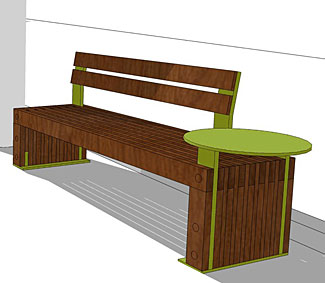
Specially-designed furniture will make it easier for Bowl patrons to get their picnic on. Image/Rios Clementi Hale
Julie Smith-Clementi of Rios Clementi Hale Studios, which oversaw the furniture project, including benches it designed for the site with manufacturer Forms and Surfaces, spent time at the Bowl last season observing how people staked out pre-concert space on the grounds. She said it was disconcerting to see patrons desperate for a place to park their picnic baskets.
“So many people were just throwing blankets onto the asphalt,” she said. “One woman was running from one area to the next, trying to find a table.”
The infusion of new furniture will expand seating at the site significantly—from about 2,001 to 2,855, a 43% increase.
Meanwhile, those who prefer a pre-concert glass of champagne to a picnic on a bench will likely be making a beeline for the new wine bar designed by Callas Architects, already being billed as “a new ‘meet-up’ landmark location.” The wine bar, next to the Bowl’s marketplace, perches above the popcorn stand, which also has been stylishly redesigned.
Barbara Callas, the architect, said she aspired to “a modernist classicism for a world-class singular amphitheater.”
“The concession space of spherical canopies mirrors the Bowl’s geometry and creates a dramatic new entry,” Callas said in a statement.
Inside the amphitheater itself, the four new LED screens stand ready to brightly beam the onstage action—in wide screen, high definition format—to patrons throughout the venue, from the boxes to the back benches. They’re designed to provide high-resolution images even in the daytime.
“The thing about the old screens is you can’t see them when it’s not completely dark,” said Samuel, the Philharmonic’s COO. “With these screens in broad daylight, we can run them and it’s a beautiful clear picture. So when our shows start at 8 or 7:30 and it’s still kind of dusk, you’ll see them from the very beginning.”
Also new this summer: an L-Acoustics K1 loudspeaker system to replace the venue’s old sound system, which had been in place since 2004. The K1 is expected to provide higher quality sound and more advanced speaker technology.
The 2013 improvements follow last year’s introduction of colorful, redesigned restrooms and a new moving walkway at the Bowl’s main entrance.
Funding for the LED screens and park furniture was provided by the office of Los Angeles County Supervisor Zev Yaroslavsky and Proposition A funds. The wine bar and loudspeaker system were underwritten by the Philharmonic.
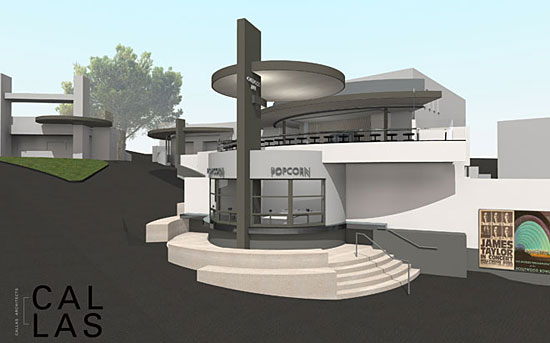
Rendering copyright Barbara Callas A.I.A. architect and principal-in-charge of the Hollywood Bowl wine bar project
Posted 5/8/13
Bingo! Beach restoration’s a winner
May 22, 2013
Just in time for the unofficial start of summer, Venice Beach has landed some national bragging rights as one of the best restored beaches in the country.
The recognition from the American Shore and Beach Preservation Association honors the $1 million restoration of a 650-yard-long stretch of Venice Beach that was severely eroded by winter storms of 2004 and 2005, and walloped again—although less severely—in 2010.
The restoration—known as “nourishment”—served to widen key areas, protect county buildings, minimize erosion and make it easier for sand to build up naturally during the summer months.
“A year and a half later, we’re looking at super-wide beaches,” said Charlotte Miyamoto, planning division chief for the Department of Beaches and Harbors.
The 2011 restoration project required transporting 30,000 cubic yards of sand from an area north of the Venice breakwater to the damaged area near county lifeguard headquarters, about a half mile south.
Venice Beach shares top honors with six other beaches around the country, including Delray Beach in Florida, Nags Head Beach in North Carolina, Pelican Island in Louisiana, and the Edgartown beach on Martha’s Vineyard in Massachusetts.
Lee Weishar, who chaired the ASBPA committee that assessed the contenders, said that beach restoration funding, particularly from the federal government, has been hard to come by in recent years. But he noted that Hurricane Sandy provided a dramatic wakeup call, with unrestored beaches damaged more profoundly than those that had been “engineered” with restoration projects.
“It’s a hard way to learn that a restored/engineered beach makes a big difference,” he said.
Miyamoto, of Beaches and Harbors, said that as the county plans for climate change, more beach restorations may be on their way.
“These are things that we’re going to have to continue doing,” she said.
Posted 5/22/13
From wizards of leadership
May 22, 2013
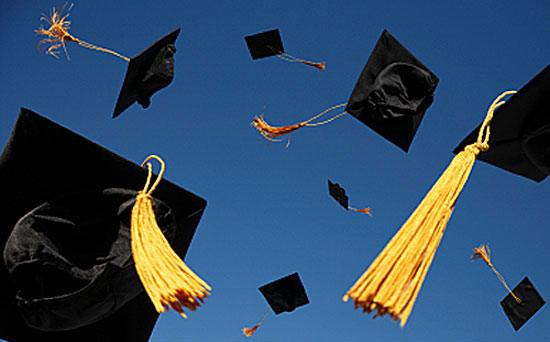
Supervisor Yaroslavsky delivered commencement remarks at the USC Annenberg School for Communication on May 17. We thought we’d share them with you here:
I am honored to address your graduating class of the Annenberg School here at USC. While I am a loyal UCLA Bruin, my mother and sister are graduates of this great university and I suppose I get partial credit for that.
As you prepare to take your place in the world, you and your peers are poised to become the leaders of tomorrow. So today, let me offer you some thoughts about leadership, drawing on some ideas of two extraordinarily successful leaders I came to know during my public service career. One is the late John Wooden, the former head basketball coach at my alma mater. The other is Steven Sample, the immediate past President of USC.
Coach Wooden is best known for his achievements in athletics, but to those of us who knew him more intimately, he was much more than that. He was a life coach and a philosopher.
Steve Sample is best known in these parts as the man who led USC into the 21st century with soaring academic achievements and a commitment to the community which this university calls home.
I had the privilege of knowing both of these men, and they both taught me a lot about leadership. I have chosen just a few of their profound and axiomatic nuggets of wisdom by which leaders should be guided.
Addressing the core issue of character, John Wooden said, “Character is more important than reputation, because reputation is merely what other people think of you; character is what you really are, and only you know what that is.”
Politics is my line of work, and I can tell you that in my profession, we spend far too much time worrying about what other people think of us and far too little pondering who we really are and communicating who we really are.
What people think of us is important. But what’s far more important are our core values—the values that we are willing to defend regardless of what others think. Or as Steve Sample said, knowing which hill we’re willing to die on. In short, who we are is ultimately informed by our character.
Wooden also reminded us: “You are your word. Don’t give your word unless you intend to keep it. A leader whose promise means everything is trusted.” The best example of this is John Wooden himself. When he came to UCLA in the late 1940’s from Indiana State University, the job he really wanted was head coach at the University of Minnesota. He waited for the call but never got it. One day, UCLA called and offered him the head coaching job in Westwood, and he accepted. The very next day, Minnesota called to offer him its job, but Wooden declined saying he had already given his word to another university.
How many of us would have made the same decision if we had been in his shoes? Times, indeed, have changed, but your word remains the highest valued currency in human relationships. A person of his word has integrity, and integrity will take you a long way in life. Don’t give your word unless you intend to keep it.
In his book, The Contrarian’s Guide to Leadership, Steve Sample urges leaders not to form an opinion about an important matter until all the relevant facts and arguments are in. Anyone who has ever served on a jury knows this, but this principle is applicable in any walk of life.
Leaders are constantly bombarded with arguments on all sides of an issue in an effort to persuade them of a particular point of view. Common sense dictates making a decision only after you’ve heard all the pros and cons. A leader who jumps to a conclusion before hearing all the facts will, more often than not, regret it. Moreover, leaders command a stronger and more loyal organization when their team members know that their opinions will be heard and valued, even if they are contrarian points of view. Avoid the temptation to jump to conclusions before you have all the facts.
Dr. Sample counseled us to become artful listeners–and, I would add, respectful listeners. Too many of those in my profession are so convinced of their monopoly on wisdom that they insist on imparting their opinions and conclusions before anyone else has even had an opportunity to weigh in. In practice, we routinely see legislators badgering witnesses with a fusillade of questions, cutting them off before the witnesses can muster even a sentence in reply, and then criticizing them for evading the question.
Listening can actually allow a leader to learn something from his subordinates. After all, leaders aren’t the only ones with good ideas. In fact, good leaders get their best ideas by keeping an open mind, and open ears, wherever they go.
A collateral benefit of listening to others is that it enables us to see things through their eyes–to walk a mile in their shoes. When you’re negotiating a contract or a peace treaty, the greatest gift a negotiator has is the ability to visualize what’s going through his adversary’s mind. It may actually lead to resolution instead of a dead end; a breakthrough instead of conflict. That’s why Sample writes that artful listening “is not just an asset—it’s a necessity.”
Sample also advised that leaders should surround themselves with people whose skills make up for their own shortcomings. I got similar advice from the late Senator Henry Jackson of Washington at the start of my career. He said, “Zev, surround yourself with people who are smarter than you are. Anything less is a waste of your time, because you’ll end up doing their work as well as your own.”
Dr. Sample and Coach Wooden both agreed that great leaders give credit to others, but accept the blame themselves. Any leader who fails to grasp this basic principle will not long endure in that leadership role. In any organization, nothing builds confidence in a team, and success in an enterprise, more than the knowledge that the leader will have your back when the going gets tough. People who feel this way about their leader will go to the ends of the earth for him. Those who don’t will do the bare minimum, if that.
Today, you become graduates in communication. An old proverb has it that “the eyes are the window of the soul”–but communication is the essence of your character. How we express ourselves is how we think, and how we think is who we are.
In politics, perception is reality. Our communication literally defines our personas for those we serve, and it’s changed enormously since I first took office. Back in the day, traditional print and broadcast outlets were the only way to get your message out.
Back then, they called me “the master of the 30-second sound-bite,” but today, if you can’t say it in six seconds, you’re out of the story. As media organizations downsize their political coverage, officials and institutions are filling the gap with their own multi-media websites, e-blasts and social media postings.
News consumers access their information on a variety of wireless platforms–podcasts, smart phones and tablets–no longer just radio, television and newspapers. But whatever form it takes, the bottom line remains that communication is transmitted through the voice of the communicator’s character.
You have been trained and taught well here at Annenberg, but as Mark Twain cautioned, “Don’t let your schooling interfere with your education.” Today, your schooling is formally completed, and I warmly congratulate you on that outstanding accomplishment. But your real education begins now, as you embark on the next chapter of your lives. As you do so, I wish you an abundance of character and wisdom. Good luck to each and every one of you.
Posted 5/22/13





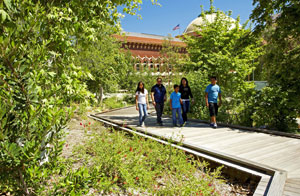
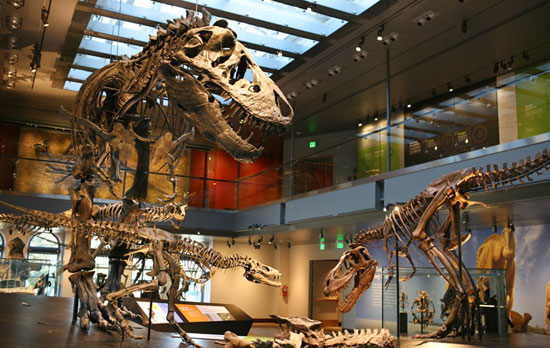
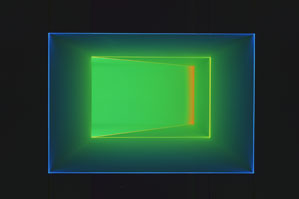
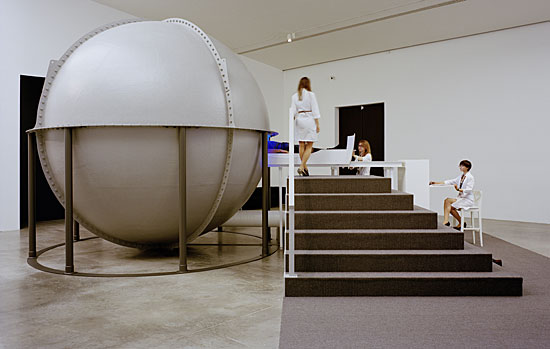

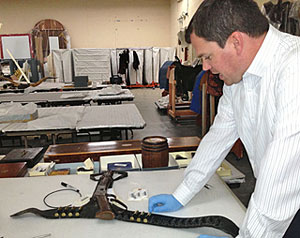

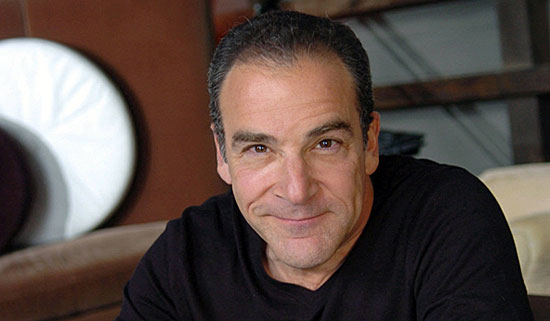
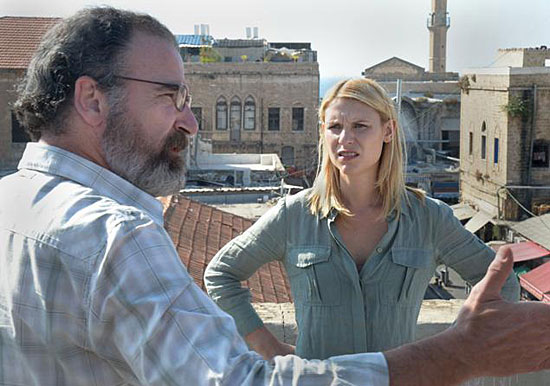
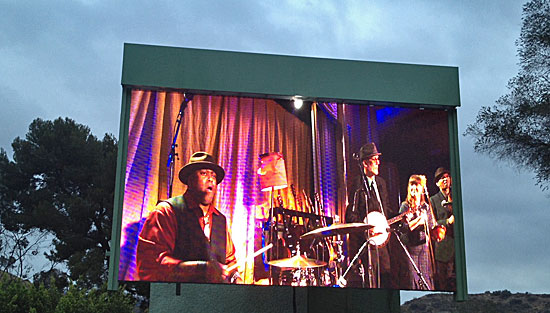
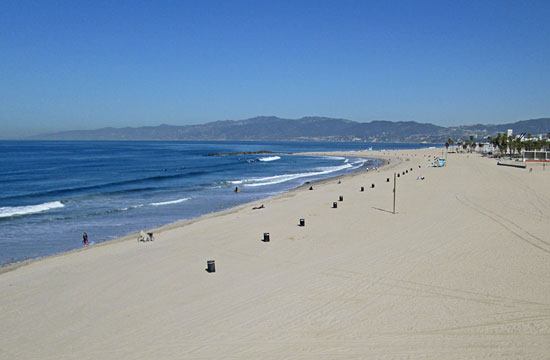





 Check for the latest closure information
Check for the latest closure information








